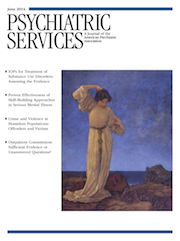Characteristics and Service Use of Homeless Veterans and Nonveterans Residing in a Low-Demand Emergency Shelter
Abstract
Objectives
This study examined use of U.S. Department of Veterans Affairs (VA) and non-VA services and predictors of service use among veterans and nonveterans who resided in a low-demand emergency shelter.
Methods
Equal numbers (N=110) of veterans and nonveterans recruited between January and June 2008 at a low-demand emergency shelter were interviewed about demographic characteristics, histories of military service and homelessness, general medical and mental functioning, current alcohol and drug problems and substance use, and use of medical, psychiatric, and substance abuse services. The Behavioral Model for Vulnerable Populations was used to identify need-based, enabling, and predisposing variables for analysis.
Results
Both groups reported high rates of arrest and incarceration, very low incomes, extensive histories of homelessness, and a similar need for services. However, significantly more veterans than nonveterans used psychiatric services, nonemergency medical services, and inpatient substance use services. Similar proportions of veterans and nonveterans used public non-VA health care services. Need-based variables appropriately predicted service use, but veterans and individuals with insurance were also more likely to access services.
Conclusions
The veterans and nonveterans residing in a low-demand shelter faced several barriers to escaping homelessness. Both groups made similar use of non-VA services, but veterans used more services overall because of their access to VA services. The predictive power of insurance indicated that veterans may experience barriers to care despite the availability of VA services. The presence of veterans in this low-demand shelter may represent evidence of barriers to veteran and other public housing services.



